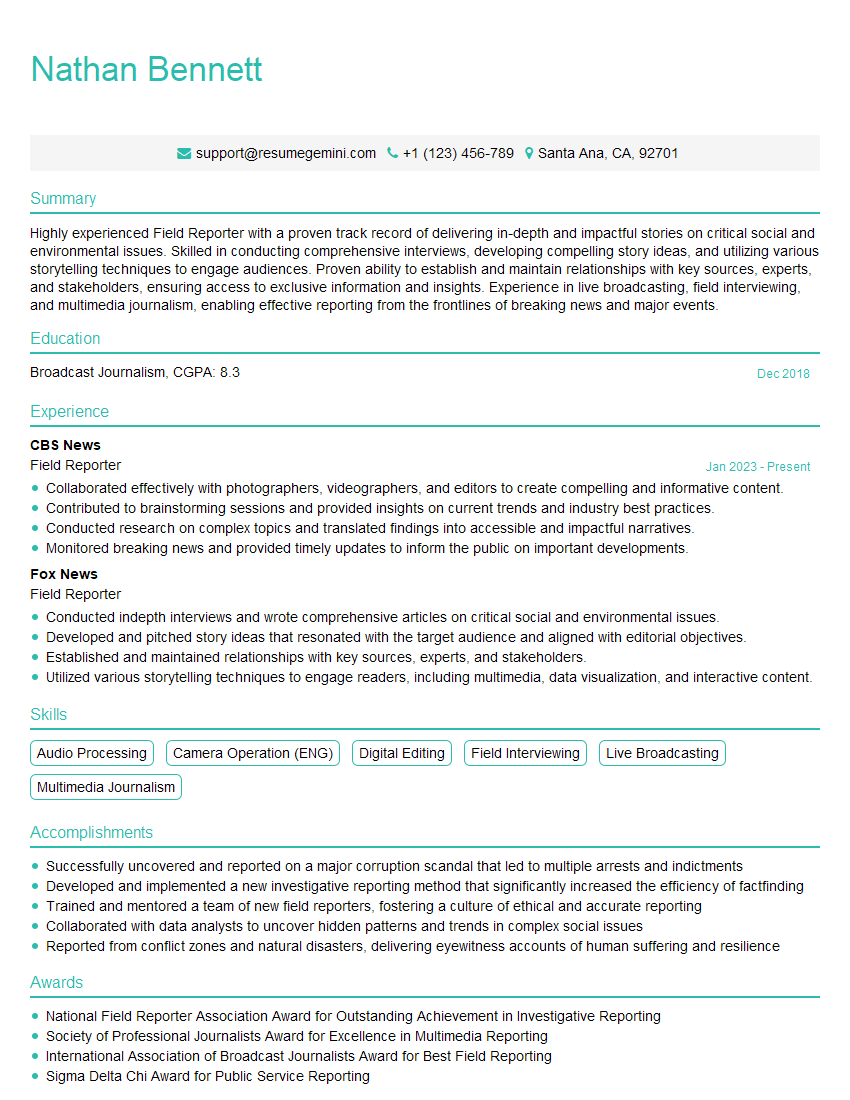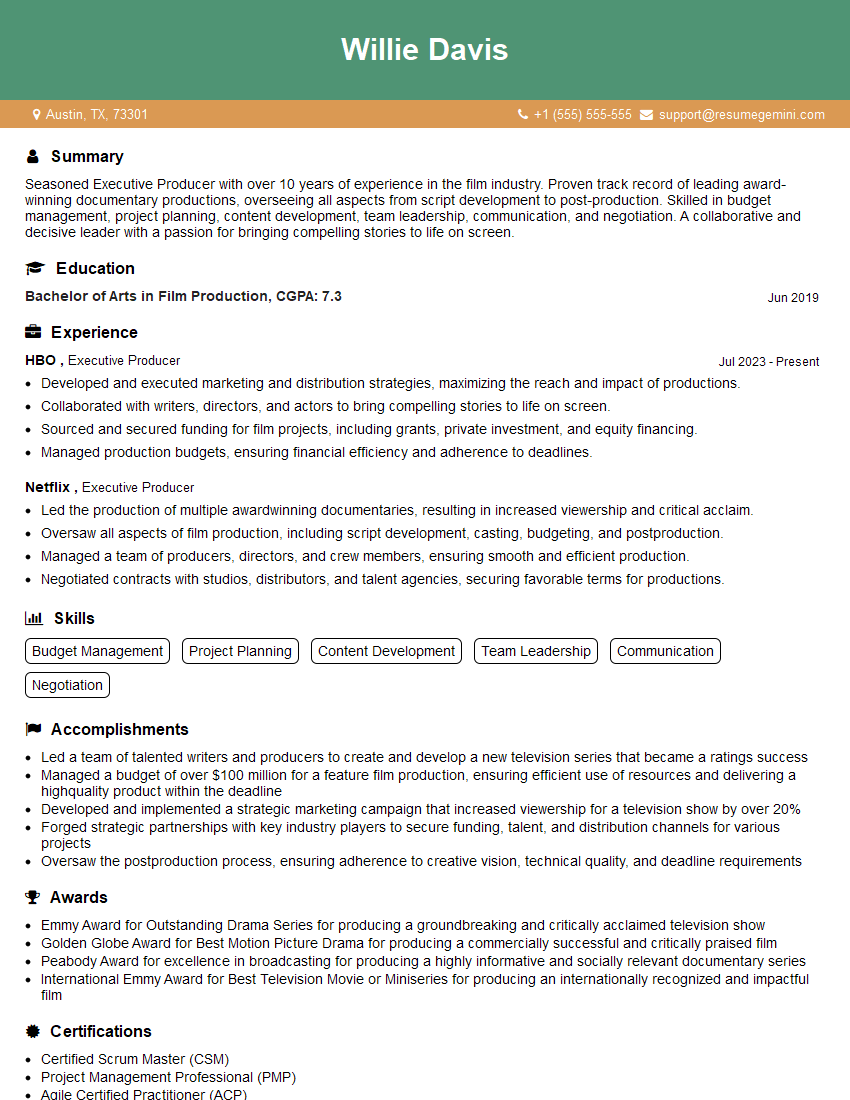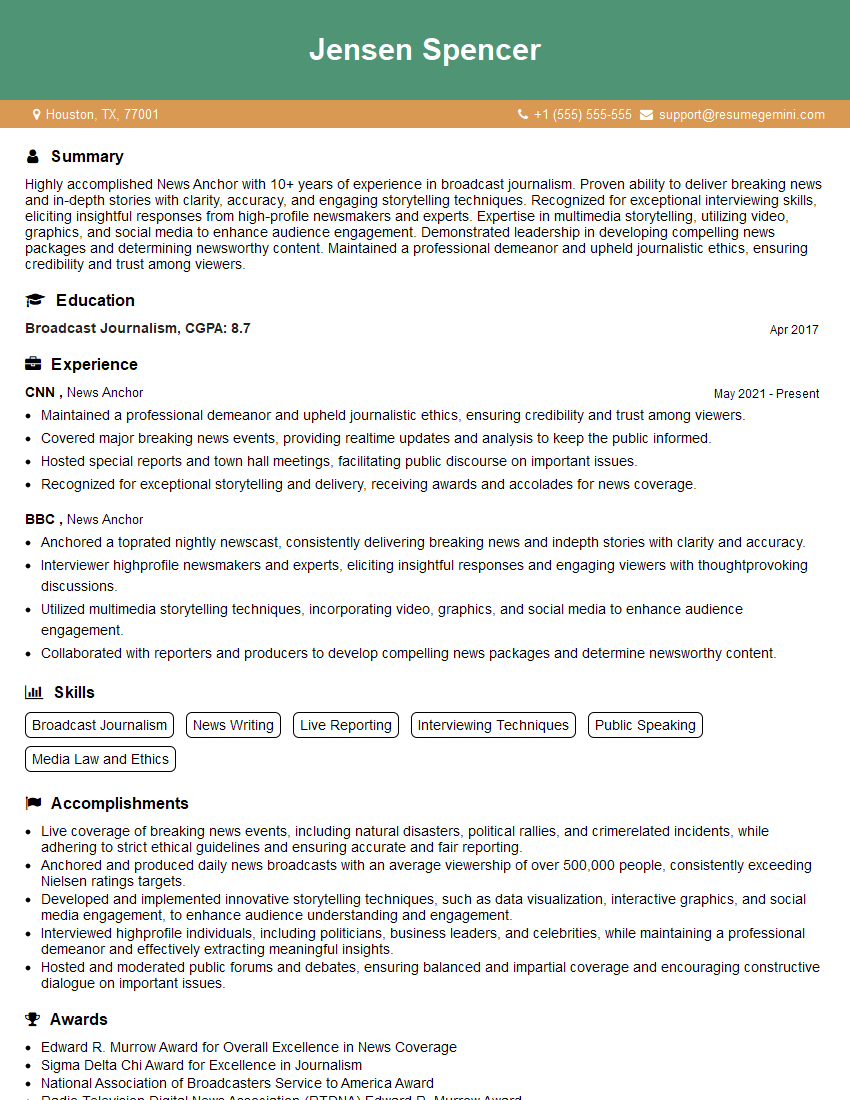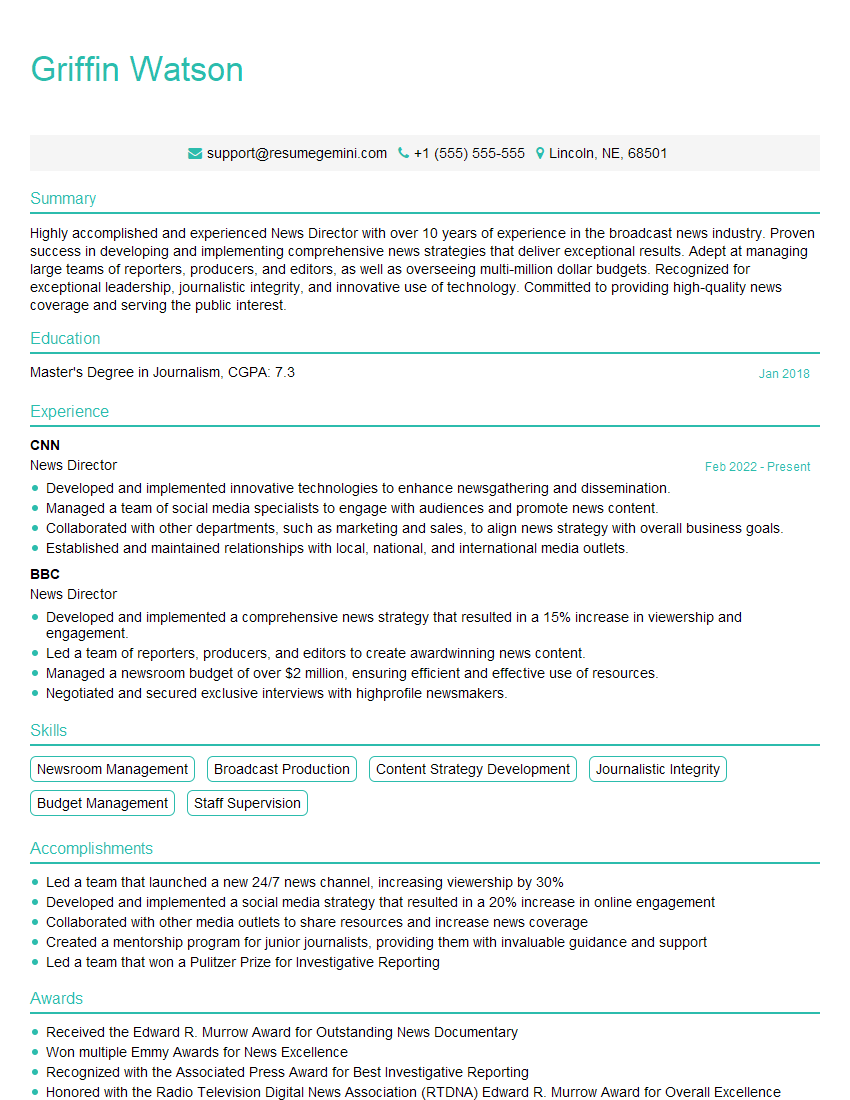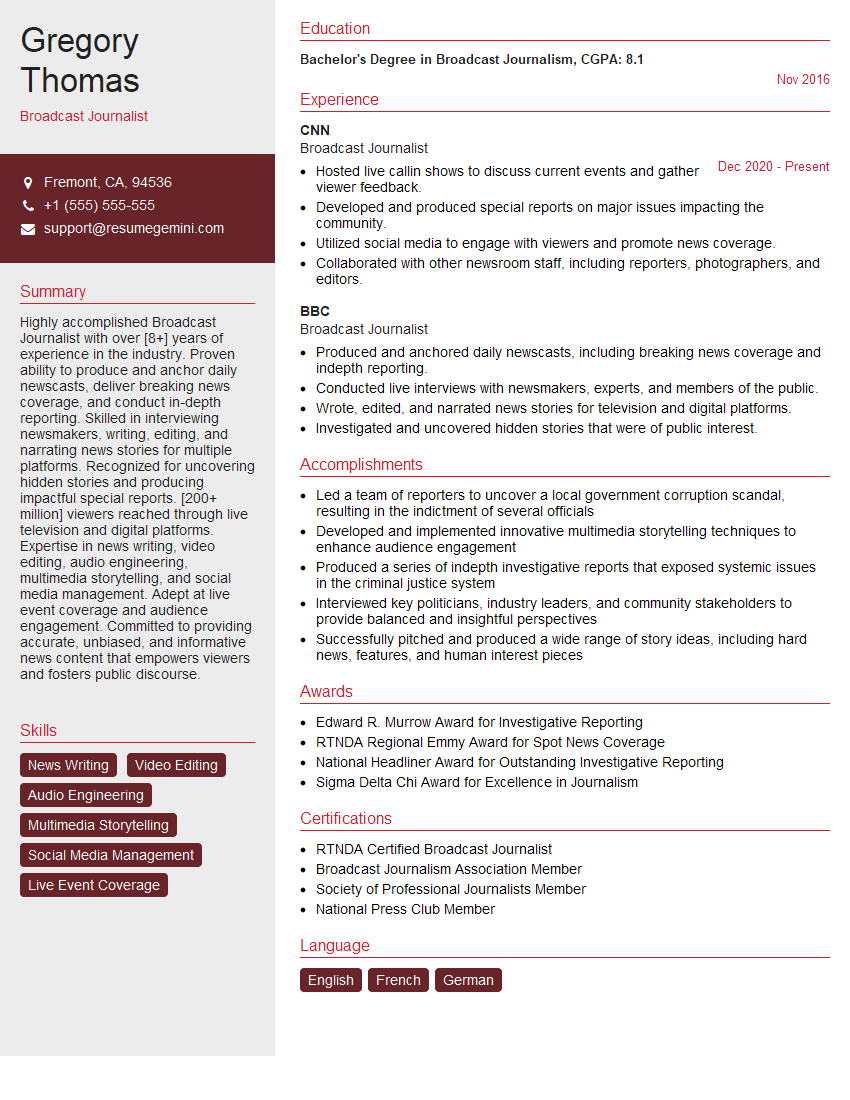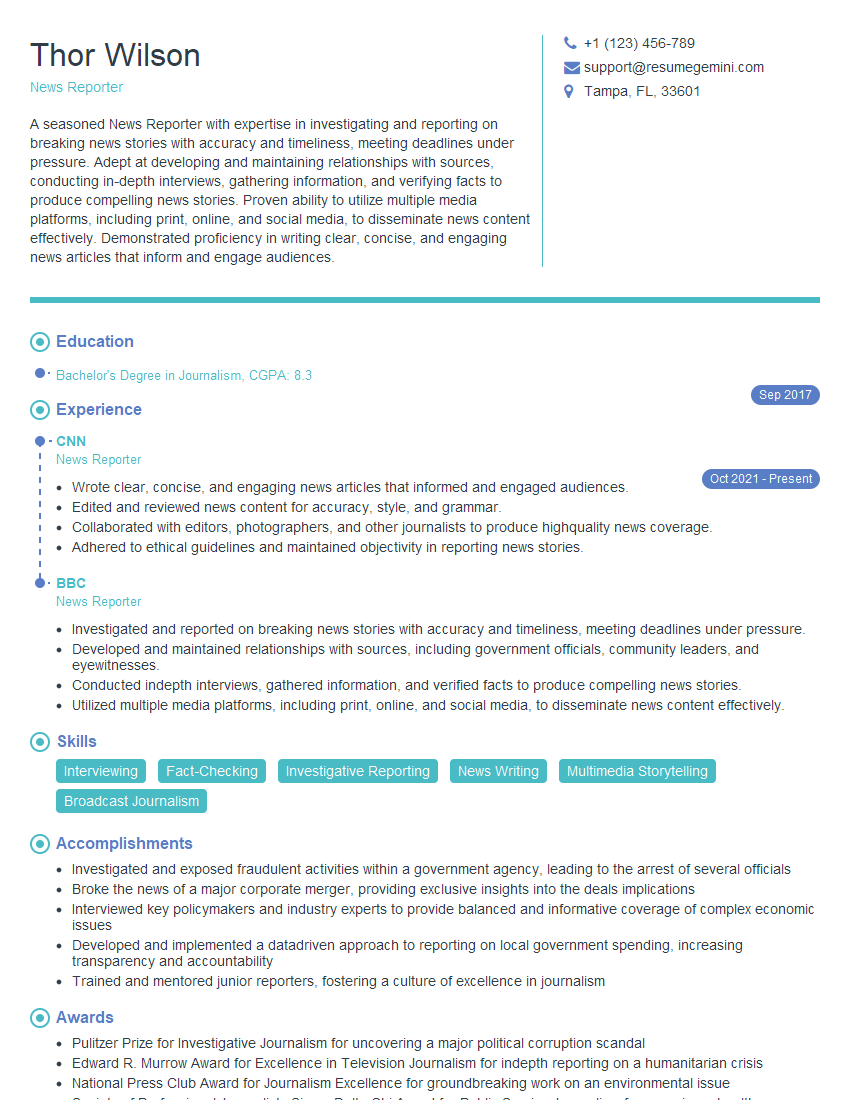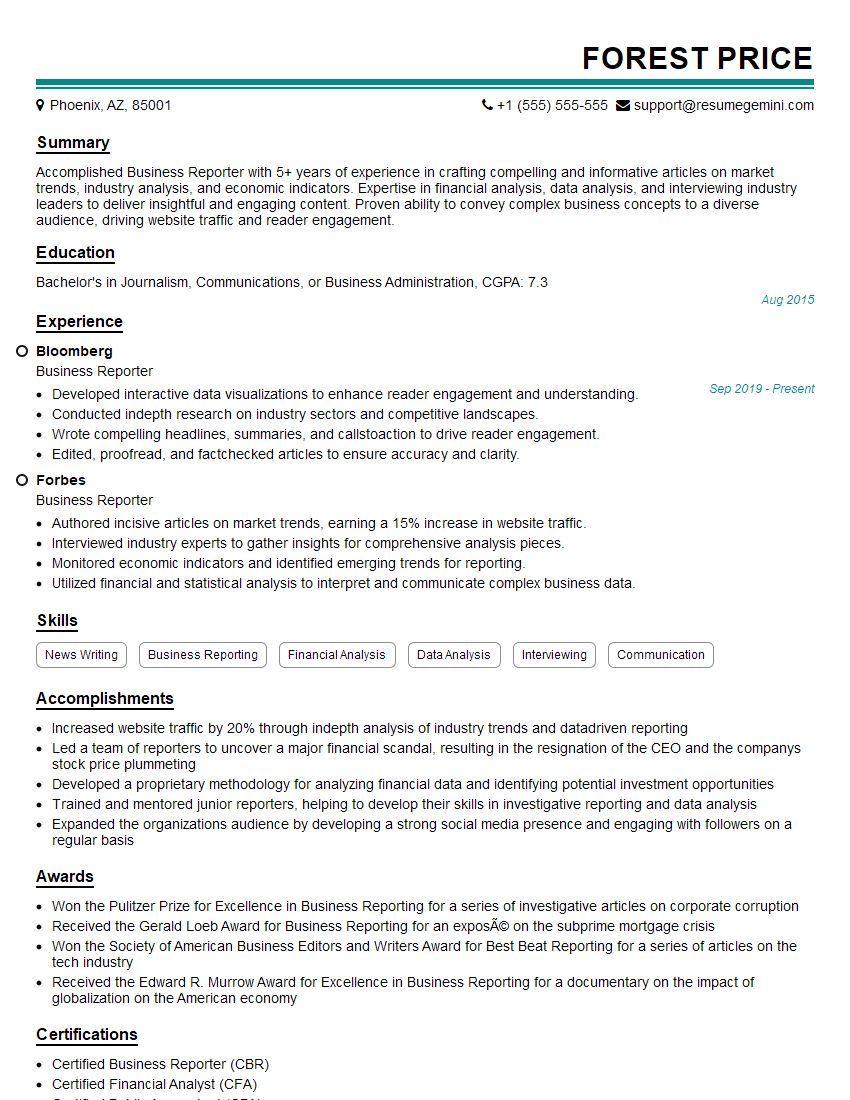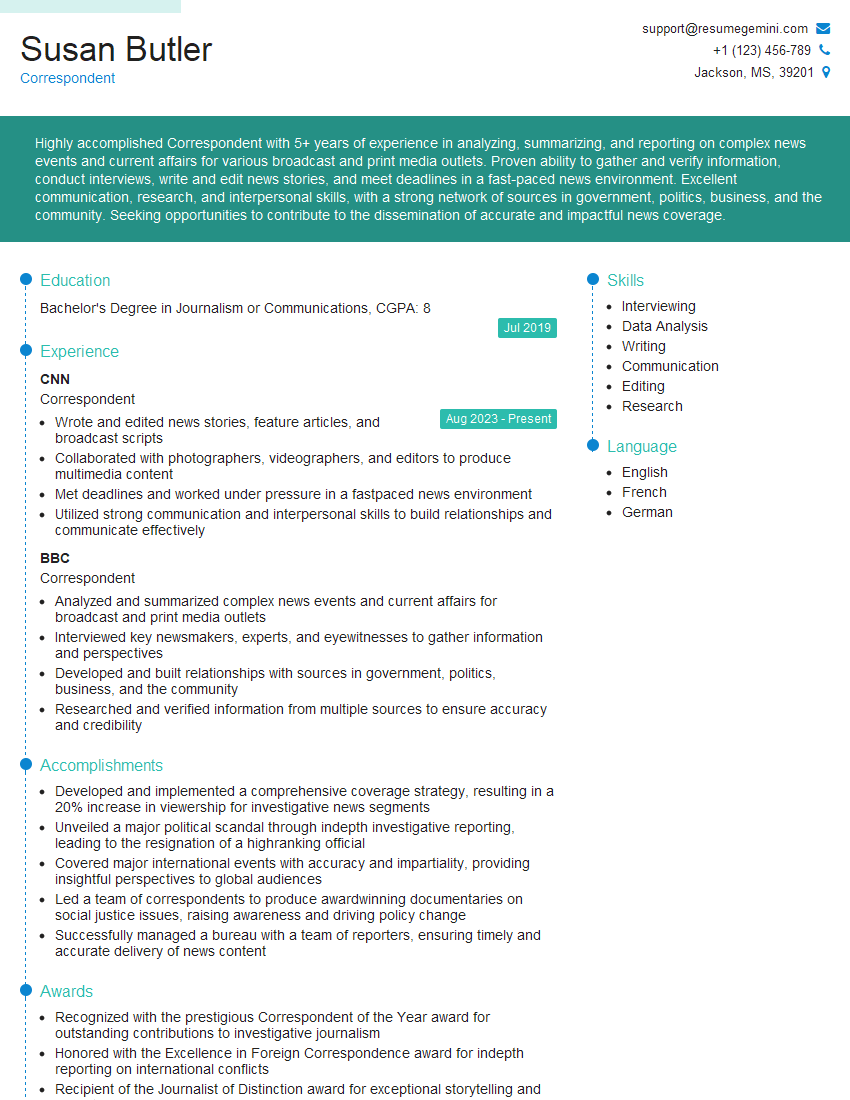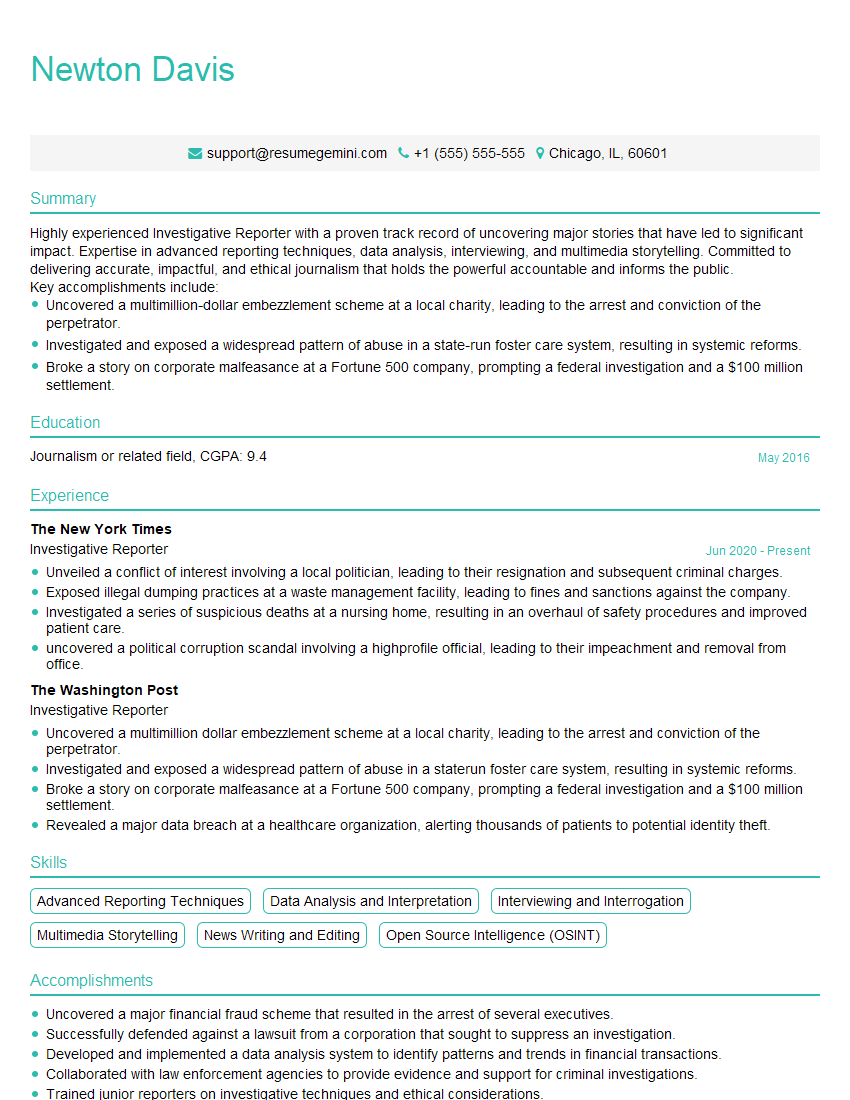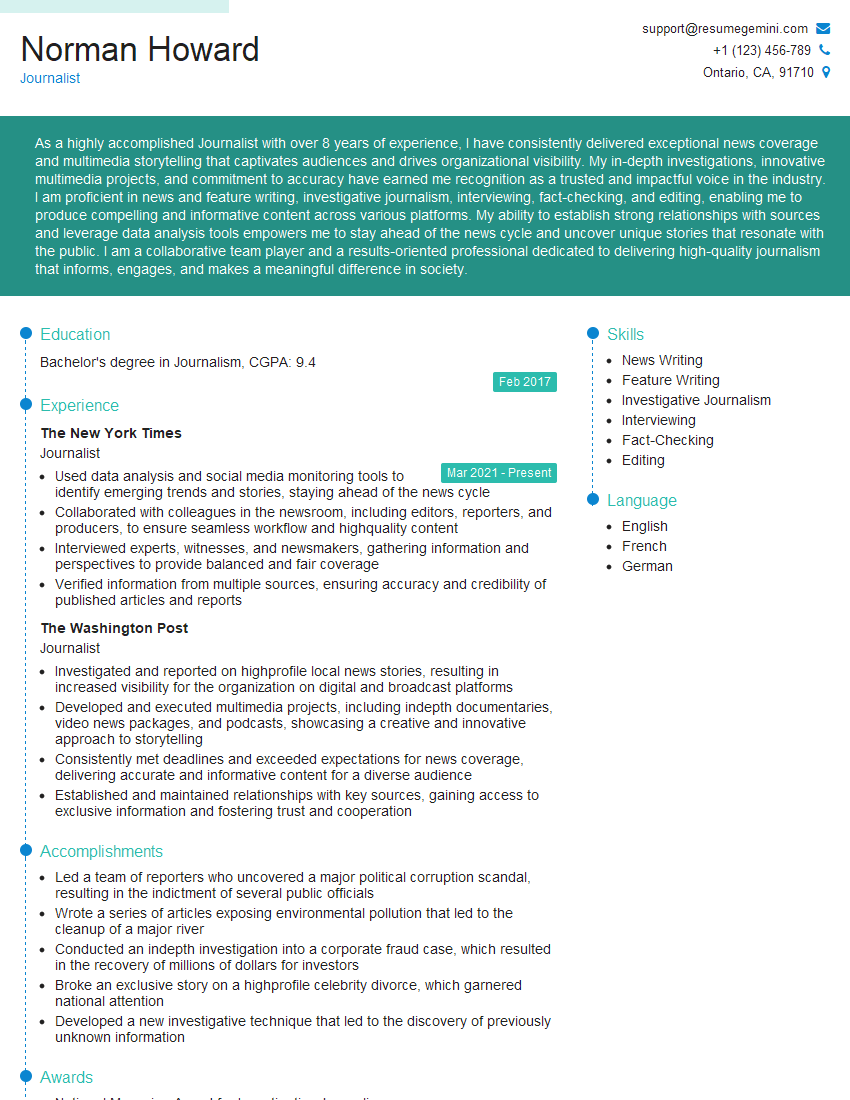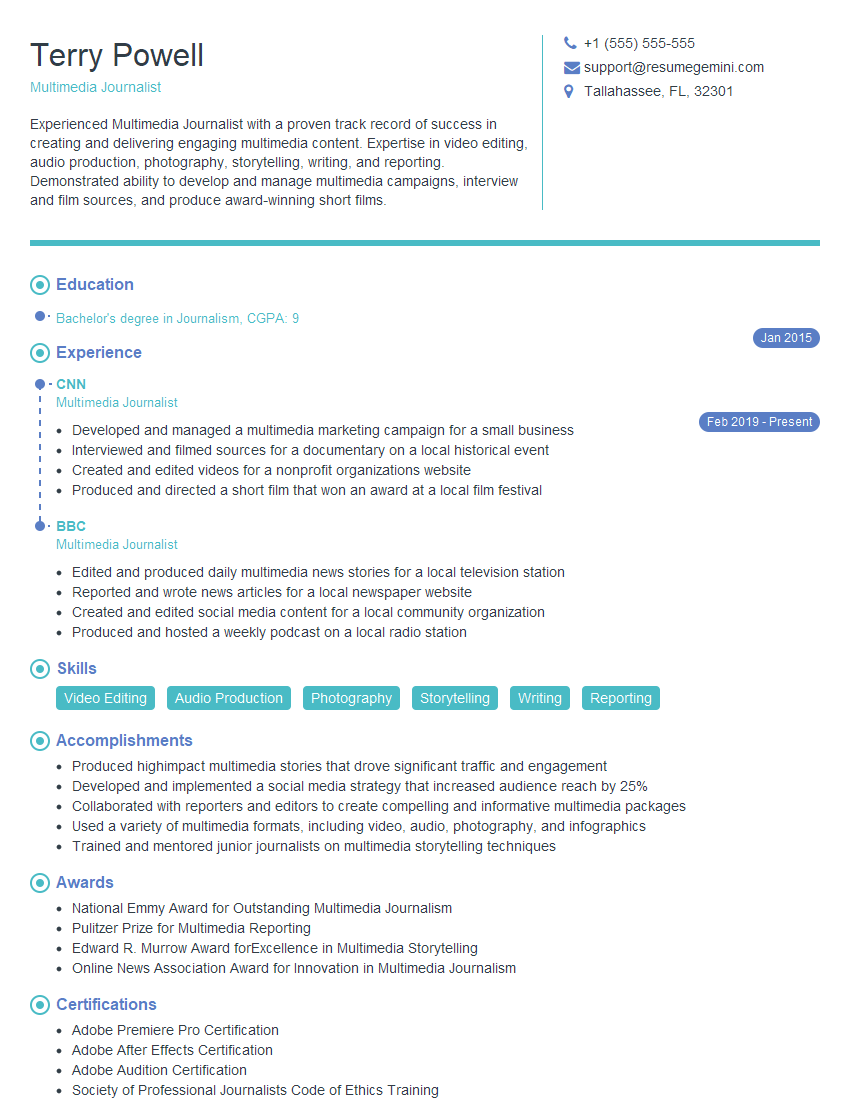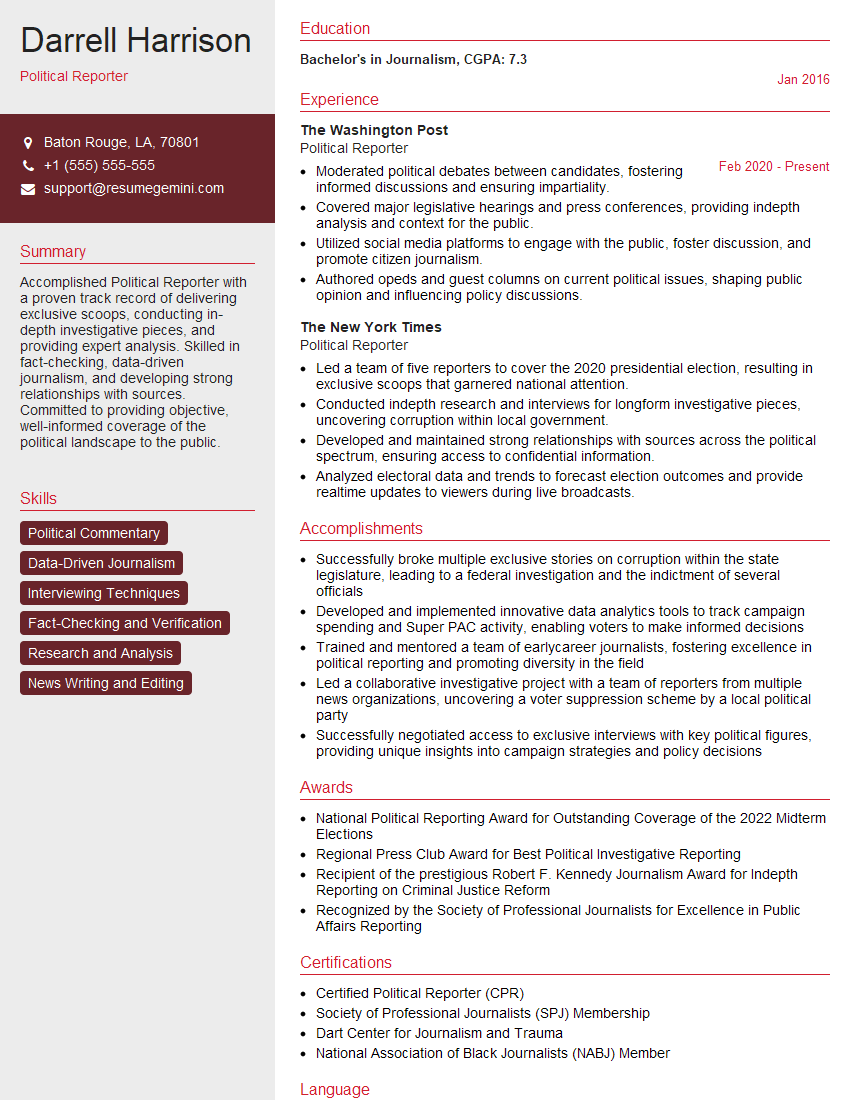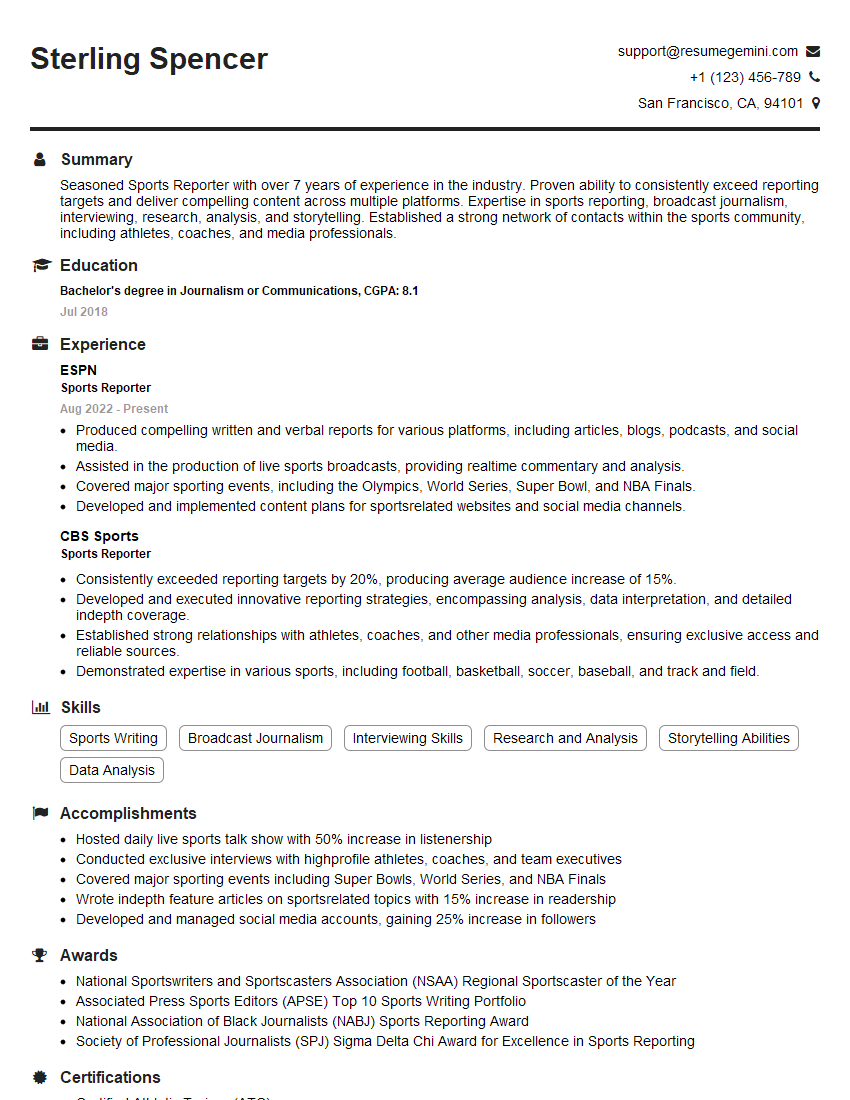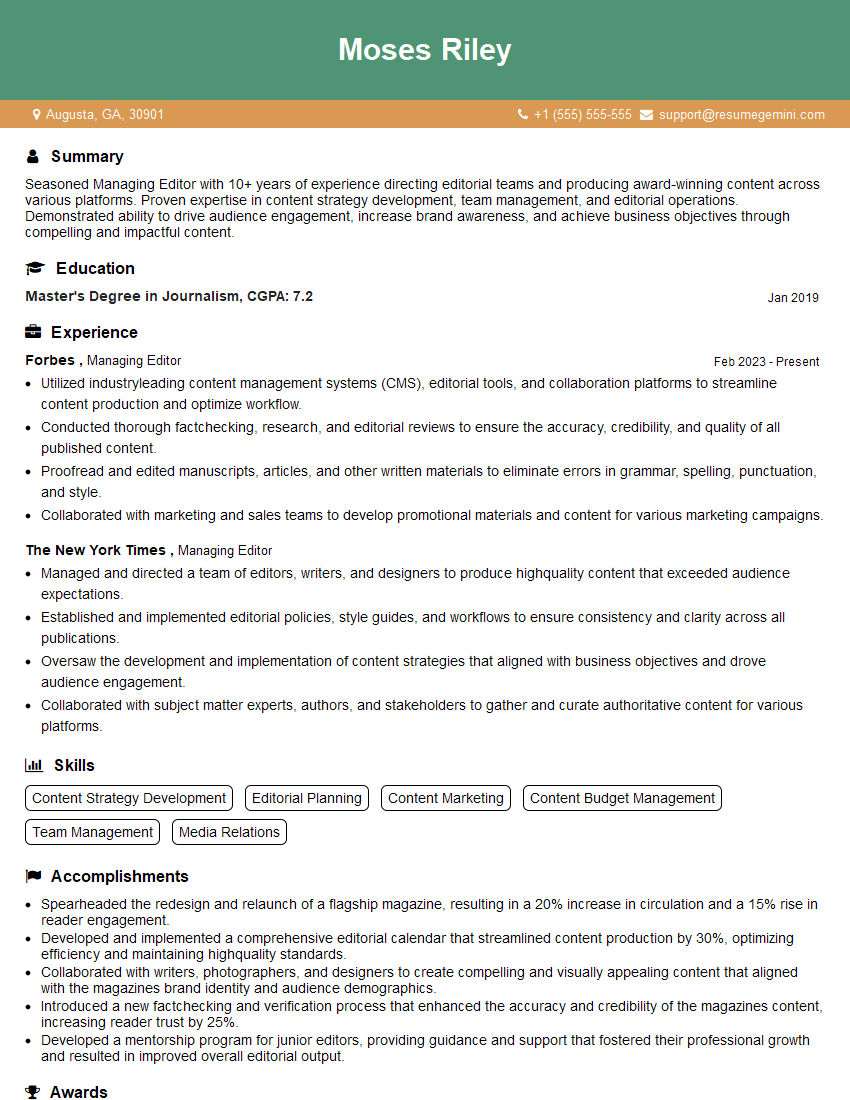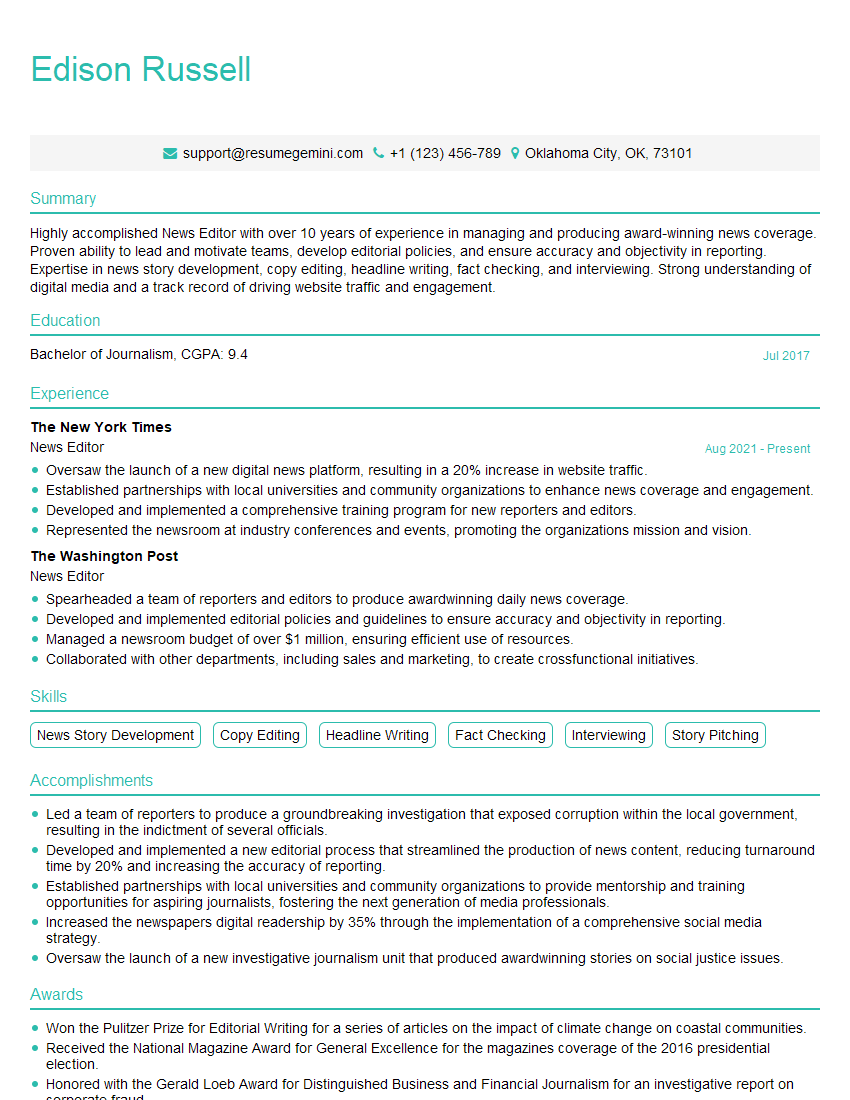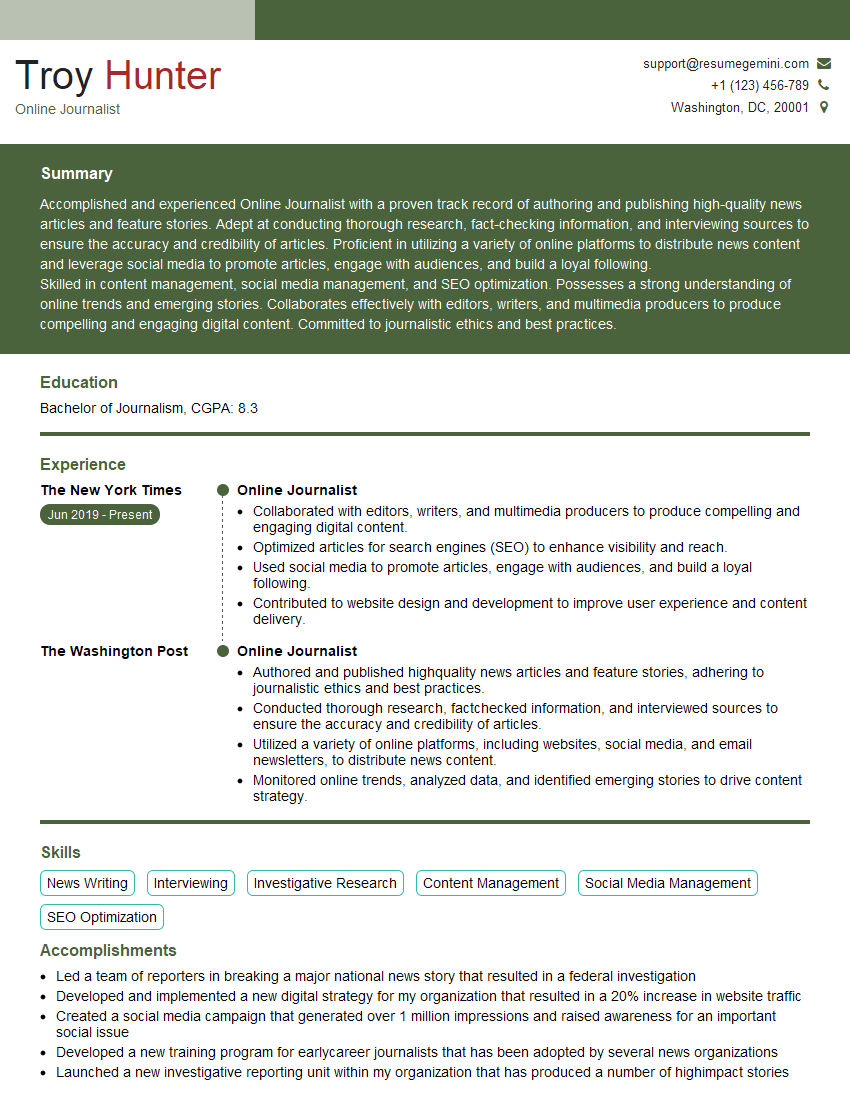Every successful interview starts with knowing what to expect. In this blog, we’ll take you through the top News Reporting interview questions, breaking them down with expert tips to help you deliver impactful answers. Step into your next interview fully prepared and ready to succeed.
Questions Asked in News Reporting Interview
Q 1. Describe your experience in gathering and verifying information for news stories.
Gathering and verifying information is the cornerstone of credible journalism. It’s a multi-step process that begins long before the writing even starts. I approach it systematically, employing a combination of techniques to ensure accuracy and reliability.
- Source Identification and Triangulation: I identify multiple credible sources – official statements, eyewitness accounts, expert opinions, and documented evidence – to corroborate information. I avoid relying on a single source, a practice known as triangulation. Think of it like building a sturdy table; three legs are far more stable than one.
- Fact-Checking and Verification: This involves meticulously checking facts, dates, figures, and quotes against reliable sources. I use various online tools and databases to cross-reference information. For example, if I’m reporting on a company’s financial performance, I’ll verify the figures against their official financial statements.
- Bias Detection and Mitigation: I’m constantly aware of potential biases in my sources and strive to present a balanced perspective. This includes considering the source’s potential motivations, affiliations, and past reporting. If a source has a clear agenda, I make sure to acknowledge it in my reporting.
- Interviewing Techniques: Effective interviewing is crucial. I prepare thorough questions beforehand, actively listen to responses, and follow up with clarifying questions to fully understand the information being conveyed. I also record interviews (with permission) to ensure accuracy.
For instance, during a recent report on a local election, I cross-referenced candidate statements with election commission records and independent poll data. This ensured the accuracy and reliability of my reporting.
Q 2. How do you prioritize multiple deadlines and competing news events?
Prioritizing deadlines and competing news events requires a strategic approach. It’s like managing a complex orchestra, where each instrument (news story) needs careful attention and coordination.
- News Judgment: I assess the newsworthiness of each event based on factors like impact, timeliness, and audience interest. The most significant and time-sensitive stories naturally take precedence.
- Time Management Techniques: I use tools like task management software and to-do lists to organize my workload. Breaking down larger stories into smaller, manageable tasks also helps.
- Collaboration and Delegation: When possible, I collaborate with colleagues, assigning tasks based on individual skills and expertise. This allows me to handle multiple stories efficiently.
- Flexibility and Adaptability: The news is constantly evolving, so I remain flexible and adaptable to changing circumstances. Sometimes, a breaking news story requires immediate attention, pushing other deadlines back slightly.
Imagine a situation where a major earthquake strikes and a political debate is scheduled for the same evening. My priority would be the immediate reporting on the earthquake, its effects, and rescue efforts. The political debate might be covered later, but the earthquake requires immediate attention due to its urgency and potential impact on a vast number of people.
Q 3. Explain your process for writing concise and accurate news reports under pressure.
Writing concise and accurate news reports under pressure is a skill honed through practice and discipline. It involves a clear understanding of journalistic principles and effective writing techniques.
- Inverted Pyramid Structure: I organize my reports using the inverted pyramid style, placing the most important information at the beginning, followed by supporting details in descending order of importance. This allows readers to quickly grasp the essence of the story.
- Conciseness and Clarity: I use precise language and avoid jargon or overly complex sentence structures. Every word serves a purpose. It’s about delivering the information efficiently without sacrificing accuracy.
- Fact-Checking and Editing: I rigorously fact-check every piece of information and then meticulously edit my work to eliminate errors and ensure clarity before publication. A second pair of eyes is always beneficial.
- Headline Writing: Crafting a compelling headline is crucial for attracting readers. It should accurately reflect the story’s main point while being concise and engaging.
For example, during a breaking news situation, I focus on delivering the core facts quickly and accurately, then adding more detail as it becomes available. This prevents the spread of misinformation while keeping the audience informed.
Q 4. How do you ensure objectivity and fairness in your reporting?
Objectivity and fairness are paramount in journalism. It means presenting information in an unbiased manner, allowing readers to form their own conclusions. This is achieved through several key strategies.
- Balanced Reporting: I present all sides of a story, giving different perspectives equal weight (unless evidence overwhelmingly favors one side). This includes presenting opposing viewpoints fairly and accurately.
- Attribution of Sources: I clearly identify my sources, allowing readers to assess the credibility of the information. Using phrases like “according to…” or “a spokesperson stated…” helps achieve this.
- Avoiding Loaded Language: I avoid emotionally charged words or phrases that might sway the reader’s opinion. Instead, I use neutral language that accurately describes events without editorializing.
- Self-Reflection and Bias Awareness: I’m conscious of my own potential biases and actively strive to mitigate their influence on my reporting. This includes seeking feedback from others and critically examining my own work.
Consider a political controversy. Instead of simply stating one side’s claims as fact, I’d present both sides’ arguments, providing supporting evidence for each. This allows the reader to form their own judgment.
Q 5. Describe a situation where you had to deal with a difficult interview subject.
I once interviewed a high-profile CEO who was reluctant to answer direct questions about a controversial company decision. The challenge was extracting accurate information while maintaining a professional relationship.
My strategy involved:
- Building Rapport: I started by engaging in friendly, non-confrontational conversation to establish trust. This helped create a more relaxed atmosphere.
- Open-ended Questions: I shifted from direct, potentially confrontational questions to more open-ended inquiries. Instead of asking “Did you mislead investors?”, I asked “Can you clarify the company’s communication strategy regarding that decision?”
- Active Listening and Patience: I listened carefully to the CEO’s responses, allowing them to express their views fully before following up with further questions. Patience was key, as some answers were indirect or evasive.
- Fact-Checking and Verification: After the interview, I rigorously fact-checked the CEO’s statements against other sources to ensure accuracy and verify the information provided.
While I didn’t get all the answers I hoped for in one session, the combination of rapport building, strategic questioning, and thorough fact-checking allowed me to produce a reasonably accurate and balanced report.
Q 6. How do you fact-check information and sources to avoid spreading misinformation?
Fact-checking is an ongoing process, not a one-time activity. It’s crucial for avoiding the spread of misinformation and maintaining journalistic integrity.
- Source Verification: I evaluate the credibility of sources by considering their reputation, expertise, and potential biases. I cross-reference information with multiple sources to verify its accuracy.
- Using Multiple Sources: This is crucial to avoid relying on unreliable or biased information. A story that is only supported by a single source needs to be treated with caution.
- Online Fact-Checking Tools: I utilize various online resources, including fact-checking websites and databases, to verify information and detect potential inaccuracies or inconsistencies.
- Primary Source Validation: Whenever possible, I seek out primary sources – original documents, recordings, or eyewitness accounts – to confirm information. This is a more reliable source of information than secondary sources.
- Context and Nuance: Understanding the context surrounding information is crucial. Information that is accurate in isolation may be misleading when placed out of context.
For example, before reporting on a scientific study, I wouldn’t just rely on a press release. I’d read the actual study, look for peer reviews, and consult with relevant experts to verify the findings and their implications.
Q 7. Explain your understanding of journalistic ethics and standards.
Journalistic ethics and standards are the bedrock of trustworthy reporting. They encompass a set of principles that guide journalists in their work, ensuring accuracy, fairness, and accountability.
- Accuracy and Verification: This is the most fundamental ethical principle. Journalists have a responsibility to ensure the accuracy of their reporting through rigorous fact-checking and source verification.
- Objectivity and Impartiality: Journalists should strive to present information objectively, avoiding bias or personal opinions that could influence the reader’s understanding.
- Fairness and Balance: All sides of a story should be presented fairly, giving different perspectives equal weight (unless evidence overwhelmingly supports one side).
- Independence and Integrity: Journalists must maintain independence from sources and avoid conflicts of interest that could compromise their objectivity.
- Accountability and Transparency: Journalists should be accountable for their work and transparent about their sources and methods. This includes readily correcting errors or admitting mistakes.
- Respect for Privacy and Confidentiality: Journalists must respect the privacy of individuals and protect confidential sources whenever possible.
Adherence to these principles helps build and maintain public trust, which is essential for the functioning of a healthy democracy. A breach of these ethics can have serious consequences, impacting the reputation of the journalist and the news organization.
Q 8. How familiar are you with AP style guidelines or other relevant style guides?
AP style is my bread and butter. I’m intimately familiar with its rules regarding punctuation, capitalization, numerals, and datelines – the bedrock of consistent, professional journalism. Beyond AP, I’m also proficient in Chicago Manual of Style and other style guides depending on the publication or platform. Understanding these guidelines isn’t just about following rules; it’s about ensuring clarity, accuracy, and consistency in communication, which builds trust with the audience. For instance, AP style dictates using numerals for numbers 10 and above, but spelling out numbers one through nine. This seemingly minor detail contributes to a publication’s overall readability and professionalism.
My experience extends to adapting to different style guides – a crucial skill in today’s diverse media landscape. I can quickly acclimate to a new style guide, ensuring consistent quality across diverse projects.
Q 9. Describe your experience working with different media platforms (print, online, broadcast).
My career has spanned various media platforms, providing a well-rounded perspective on news delivery. In print journalism, I honed my skills in crafting concise, impactful narratives that translate effectively onto the page. I understand the limitations of space and the importance of strong headlines and lead paragraphs. Online, my focus shifts to optimizing content for search engines (SEO) while maintaining journalistic integrity. I’ve utilized multimedia elements like photos and videos to enhance online storytelling, reaching a broader and more engaged audience.
Broadcast journalism added another dimension – the urgency and immediacy of live reporting. I’ve learned to write for the ear, crafting scripts that are clear, concise, and easily understandable for listeners. Adapting to each platform’s unique characteristics is vital, and it’s a skill I’ve refined through consistent experience. For example, a compelling print story might need to be drastically shortened for a radio broadcast, focusing on the most important elements.
Q 10. How do you adapt your reporting style to suit different audiences?
Adapting my reporting style involves understanding the audience’s background, knowledge level, and interests. A technical story for a science journal requires a different approach than a news report for a general audience newspaper. For example, when writing for a specialized scientific publication, I’d include detailed technical information and jargon. Conversely, reporting for the general public demands simplification and avoiding overly technical language. I use plain language, clear explanations, and relatable analogies to connect with readers of all backgrounds. Understanding your audience’s needs is paramount to effective communication and building trust.
Age also plays a role. Younger audiences might respond better to visually rich, concise content, while older audiences might prefer longer, more detailed articles. Tailoring the style to the platform – whether it’s a tweet, a blog post, or a long-form article – is also crucial.
Q 11. How proficient are you in using newsgathering tools and technologies?
I’m highly proficient in a wide range of newsgathering tools and technologies. This includes utilizing content management systems (CMS) like WordPress and Drupal for publishing, social media monitoring tools like Hootsuite and Tweetdeck for tracking trending topics and news sources, and database software for analyzing data. I am skilled in using advanced search techniques to find information online. I’m also experienced with audio and video recording and editing equipment and software. The ability to quickly and efficiently utilize these tools is essential in today’s fast-paced news environment.
Furthermore, I’m familiar with various transcription services and fact-checking tools. Staying current with technological advancements is a continuous process, and I actively seek opportunities to expand my skill set in this area.
Q 12. Explain your experience in using social media for newsgathering and dissemination.
Social media is an indispensable tool in modern newsgathering and dissemination. I leverage platforms like Twitter, Facebook, and Instagram to identify breaking news, verify information from multiple sources, and engage with the public. For example, during a local emergency, I might monitor social media for eyewitness accounts or citizen journalism, but always verifying information through other reliable channels. This allows for real-time updates and a faster news cycle.
Dissemination involves strategically using social media to reach wider audiences and promote published articles. However, I’m mindful of the ethical considerations involved in using social media, prioritizing responsible and accurate information dissemination over sensationalism. I always verify the credibility of sources before sharing information.
Q 13. How do you handle criticism or negative feedback about your reporting?
Criticism and negative feedback are inevitable aspects of journalism. I approach it as an opportunity for growth and improvement. First, I thoroughly analyze the feedback, identifying valid points and separating constructive criticism from unsubstantiated attacks. If the criticism highlights factual inaccuracies or biases, I address them immediately and make corrections, potentially issuing a public correction if necessary.
If the criticism stems from a misunderstanding, I engage with the person expressing it, clarifying my reporting and explaining my reasoning. I believe in transparency and open communication, fostering a dialogue to build trust and understanding. The goal is to learn from mistakes and improve future reporting, ensuring greater accuracy and objectivity.
Q 14. Describe a time you had to make a difficult ethical decision in your reporting.
During a story involving a local business accused of unethical practices, I faced an ethical dilemma. I had obtained information from a confidential source that corroborated the allegations, but the source requested anonymity, raising concerns about the verification process. I weighed the public’s right to know against the source’s protection and the need to maintain journalistic integrity.
My solution was to meticulously verify the information from other independent sources, strengthening the story’s credibility. I also consulted with my editor and legal counsel to determine the best approach to handling the anonymous source’s information while protecting their identity to the best of my ability. This involved carefully redacting certain details while still presenting the core allegations and evidence in a responsible and ethical manner. The final story was published, but my focus remained on responsible reporting that balanced public interest with the ethical obligations to all involved.
Q 15. How do you maintain confidentiality of sources when necessary?
Protecting the confidentiality of sources is paramount in ethical journalism. It’s a promise I take very seriously, understanding that it builds trust and allows individuals to come forward with crucial information without fear of reprisal. My approach is multifaceted:
- Establishing Clear Agreements: Before an interview, I explicitly discuss the terms of confidentiality, outlining what information will remain anonymous and under what conditions. This is often documented in writing, though not always, depending on the sensitivity.
- Source Protection Techniques: I avoid using identifying details like full names or specific addresses in my reporting unless the source explicitly consents. I might use pseudonyms or only describe identifying characteristics in general terms. For example, instead of saying “Jane Doe, resident of 123 Main Street,” I might say “a resident of the city’s downtown area.”
- Secure Communication: I utilize encrypted communication channels where appropriate, particularly when dealing with sensitive material. This helps safeguard information during the reporting process.
- Legal Considerations: I’m familiar with shield laws and journalistic privileges that protect sources in certain jurisdictions. I understand the limitations of these protections and advise sources accordingly.
- Maintaining Discretion: Beyond technical measures, confidentiality also requires meticulous discretion in my interactions and professional conduct. I understand the importance of protecting my sources even from casual conversations.
For instance, in a story about corruption in a local government, I successfully protected my sources – whistleblowers within the agency – by carefully choosing my words and using pseudonyms while ensuring the integrity of the story remained intact. The story ultimately led to an investigation.
Career Expert Tips:
- Ace those interviews! Prepare effectively by reviewing the Top 50 Most Common Interview Questions on ResumeGemini.
- Navigate your job search with confidence! Explore a wide range of Career Tips on ResumeGemini. Learn about common challenges and recommendations to overcome them.
- Craft the perfect resume! Master the Art of Resume Writing with ResumeGemini’s guide. Showcase your unique qualifications and achievements effectively.
- Don’t miss out on holiday savings! Build your dream resume with ResumeGemini’s ATS optimized templates.
Q 16. How do you identify and cover breaking news events effectively?
Breaking news demands speed, accuracy, and a methodical approach. My process begins with rapid information gathering from diverse and reliable sources. This involves:
- Monitoring News Feeds: I constantly monitor news wires, social media, and official channels for developing events. This allows me to identify emerging stories quickly.
- Verifying Information: Speed is crucial, but accuracy is paramount. I cross-reference information from multiple reliable sources to verify facts before publishing anything. I’m wary of unverified social media posts or anonymous tips.
- Establishing Contacts: A strong network of contacts – from law enforcement to eyewitnesses – is invaluable. These relationships allow for quicker access to information and perspectives.
- On-the-Scene Reporting: When possible, I go to the location of the event to gather firsthand information and observations. This provides context and detail that cannot be obtained remotely.
- Multiple Reporting Angles: I aim to present a comprehensive picture by exploring the story from different angles, interviewing various stakeholders, and considering different perspectives.
During a major storm, for example, I used a combination of weather alerts, social media updates, and contact with emergency services to provide real-time updates to readers, while always carefully verifying information to avoid spreading misinformation.
Q 17. Explain your experience with writing different types of news stories (e.g., hard news, features).
My experience encompasses a wide range of news writing styles. I’m comfortable with hard news, features, and other formats:
- Hard News: I excel at writing concise, factual accounts of current events, focusing on the ‘who, what, when, where, why, and how.’ This requires precision and an understanding of journalistic principles like inverted pyramid style.
- Features: My feature writing allows for greater depth and exploration. I use narrative techniques and character development to engage readers and provide context beyond the immediate facts. A recent feature on a local artist’s journey exemplifies this style.
- Investigative Journalism: I am skilled in conducting in-depth research, analyzing data, and uncovering hidden truths. This requires patience, persistence, and a rigorous approach to fact-checking.
- Profiles: I can craft compelling profiles of individuals, highlighting their lives and accomplishments or struggles. This involves thorough research and insightful interviews.
Adaptability is key. I can tailor my writing style to meet the specific demands of each assignment and the publication’s style guide. I’ve successfully written hard-hitting reports on political scandals as well as heartwarming features on community initiatives.
Q 18. How do you conduct interviews to obtain accurate and compelling information?
Effective interviewing is a cornerstone of my reporting. It’s about obtaining accurate, compelling information while building rapport with the interviewee. My approach involves:
- Preparation: I always research the interviewee and the subject thoroughly beforehand. This allows me to ask informed and insightful questions.
- Establishing Rapport: I create a comfortable atmosphere to encourage open communication. This involves active listening and demonstrating genuine interest.
- Open-Ended Questions: I primarily use open-ended questions that encourage detailed answers and reveal deeper insights. Avoid leading questions that can bias the response.
- Active Listening: I pay close attention to both the verbal and nonverbal cues of the interviewee, enabling me to follow up on interesting points and delve deeper into specific topics.
- Fact-Checking: I meticulously verify information obtained during the interview using multiple sources.
In a recent interview with a local politician, my thorough preparation and ability to ask insightful questions allowed me to uncover inconsistencies in their statements, leading to a significant story.
Q 19. Describe your experience with video editing or audio production (if applicable).
While my primary focus is text-based reporting, I possess experience in video editing and audio production, enhancing my ability to tell stories in a more dynamic and engaging way.
- Video Editing: I’m proficient in using video editing software (such as Adobe Premiere Pro or Final Cut Pro) to assemble footage, add graphics, and create a polished final product. I understand the importance of visual storytelling and how to use video to enhance a narrative. I’ve worked on multiple video news packages that successfully blended interviews and b-roll footage.
- Audio Production: I have experience recording and editing audio using programs like Audacity or GarageBand. This is essential for podcasts, radio reports, and enhancing the audio quality of video projects. I understand the importance of clear sound and how to remove background noise effectively.
A recent project required me to edit raw interview footage into a concise, impactful video piece for our online news platform. The result showcased my ability to both select and condense critical information while preserving the integrity and natural flow of the interviews.
Q 20. How do you handle conflicts or disagreements within a news team?
Disagreements within a news team are inevitable, but they can be constructively resolved through open communication and respect for diverse perspectives. My approach emphasizes:
- Collaborative Problem-Solving: I encourage open discussion of disagreements, focusing on finding common ground and solutions that benefit the overall project. This might involve brainstorming alternatives or seeking a neutral third party’s opinion.
- Respectful Dialogue: I always strive to maintain respectful communication, even when expressing differing viewpoints. This creates a safe space for voicing concerns without fear of reprisal.
- Adherence to Editorial Standards: We always resolve disputes based on established journalistic ethics and editorial guidelines. These standards provide a framework for evaluating the merits of different arguments.
- Compromise: Sometimes, reaching a compromise requires adjusting individual preferences to achieve a unified outcome. This shows flexibility and a commitment to teamwork.
In one instance, a disagreement arose about the angle of a story. Through respectful debate and collaborative discussion, we found a compromise that strengthened the final piece, making it more balanced and informative.
Q 21. How do you stay updated on current events and industry trends?
Staying abreast of current events and industry trends is essential for any journalist. My strategies include:
- Diverse News Consumption: I regularly consume news from various reputable sources, including international and national outlets, to gain a comprehensive understanding of events and perspectives.
- Professional Development: I participate in workshops, conferences, and online courses to stay updated on new reporting techniques, technologies, and ethical considerations. This includes staying informed on evolving media landscapes.
- Industry Publications and Blogs: I follow prominent journalism publications and blogs to learn about best practices and industry trends. This helps me to refine my skills and approaches.
- Networking: I maintain a strong professional network to learn from colleagues’ experiences and engage in discussions about current issues.
- Critical Self-Reflection: I regularly reflect on my own work, identifying areas for improvement and seeking feedback from editors and peers.
For example, I recently attended a workshop on data journalism, which enhanced my ability to analyze data and integrate it into my reports, resulting in a more data-driven approach to investigative journalism.
Q 22. Explain your understanding of copyright and intellectual property issues in journalism.
Copyright and intellectual property (IP) are crucial in journalism. Copyright protects original creative works, like articles and photos, giving the creator exclusive rights to control their use. IP encompasses broader rights, including trademarks (brand names) and patents (inventions), though less directly relevant to typical news reporting. In journalism, respecting copyright means obtaining permission before using someone else’s copyrighted material, whether it’s a photo, a quote from a copyrighted book, or even a significant portion of another news outlet’s story. Failing to do so can lead to legal action and reputational damage.
For instance, using a photograph from Getty Images without a license is a copyright infringement. Similarly, verbatim reproduction of a lengthy passage from a published book necessitates permission from the copyright holder. Fair use is an exception, allowing limited use of copyrighted material for purposes like criticism, commentary, news reporting, teaching, or research, but this is a complex legal area best navigated with caution and, often, legal counsel.
Practical application often involves meticulous citation, crediting sources properly, and verifying permissions. News organizations have internal policies and legal teams to guide journalists in navigating these issues. Understanding and adhering to copyright and IP laws is not just about avoiding legal trouble; it’s also about ethical conduct and respecting the creative work of others.
Q 23. Describe your experience in working with data visualization tools (if applicable).
I have extensive experience with various data visualization tools, including Tableau, Power BI, and Datawrapper. My experience extends beyond simply creating charts and graphs; I understand the importance of choosing the right visualization for the data and the story being told. For instance, a bar chart might be best for comparing categories, while a line chart might be more suitable for showing trends over time. A poorly chosen visualization can misrepresent data and confuse the audience.
In my previous role at [Previous Company Name], I used Tableau to create interactive dashboards visualizing crime statistics across different neighborhoods. This allowed readers to explore the data themselves, filtering by time, crime type, and location. This interactive element significantly increased user engagement and understanding of the complex data. In another project, I utilized Datawrapper’s simplicity to quickly create compelling visualizations of election results, ensuring timely and accurate presentation of information to readers.
My approach emphasizes clarity, accuracy, and accessibility. I focus on creating visualizations that are not only visually appealing but also easy to interpret, even for readers with limited data literacy. This includes careful labeling, concise explanations, and a focus on the key takeaway messages.
Q 24. How do you measure the success of a news story?
Measuring the success of a news story isn’t just about website traffic or social media shares, although those metrics are valuable. A truly successful story achieves its intended goals, which often include informing the public, sparking debate, driving change, or holding those in power accountable. A multi-faceted approach is necessary.
- Audience Engagement: Website traffic, social media interactions (likes, shares, comments), and email engagement are good indicators of audience interest and reach.
- Impact: Did the story lead to any changes in policy, public opinion, or individual behavior? For example, did a story about unsafe working conditions lead to an investigation and improved safety measures?
- Accuracy and Integrity: Did the story accurately reflect the facts, and was it reported ethically? This is paramount, even if the story doesn’t generate huge numbers.
- Reader Feedback: Direct feedback, whether positive or negative, offers valuable insights into how the story resonated with the intended audience.
For example, a story investigating corruption might not receive widespread viral sharing but could trigger a formal investigation and ultimately lead to policy reform. That’s a sign of significant success even if the website analytics weren’t outstanding.
Q 25. How do you manage your time effectively when working on multiple assignments?
Effective time management is crucial in journalism, particularly when juggling multiple assignments with competing deadlines. My approach is based on a combination of planning, prioritization, and efficient workflow.
- Prioritization: I begin by prioritizing tasks based on urgency and importance, using methods like the Eisenhower Matrix (urgent/important). Deadlines are a major factor.
- Detailed Planning: I break down large assignments into smaller, manageable tasks with allocated time slots. This approach avoids feeling overwhelmed and allows for better tracking of progress.
- Time Blocking: I dedicate specific time blocks for particular tasks, minimizing distractions during those periods. This focused work enhances efficiency.
- Regular Check-ins: I regularly review my schedule and adjust as needed, accounting for unexpected delays or changes in priorities.
- Delegation (where applicable): When possible, I delegate tasks to colleagues to ensure optimal use of team resources.
Using project management tools can also help streamline the process. Ultimately, good time management is a continuous process of refinement, constantly adapting to the demands of the job and individual work style.
Q 26. Describe your experience with SEO and content optimization (for online journalists).
SEO and content optimization are essential skills for online journalists. It’s about making sure your stories are easily discoverable by search engines and engaging for readers. My experience includes keyword research using tools like SEMrush and Ahrefs to identify relevant search terms related to my stories. I then incorporate those keywords naturally within the headline, subheadings, body text, and meta descriptions.
Beyond keyword integration, I focus on creating high-quality, well-structured content. This includes using clear and concise language, optimizing images with alt text, and structuring content with proper headings and subheadings. Understanding user experience (UX) is vital; I make sure stories are easy to read and navigate on different devices.
For example, when writing about a local election, I would research relevant keywords like ‘[City Name] election results,’ ‘[Candidate Name] platform,’ and ‘[Local Issue] election.’ This ensures the story shows up in search results for people looking for that information. I would also ensure the headline is compelling, the story is well-structured, and the images are appropriately optimized. Regular monitoring of website analytics helps assess the effectiveness of SEO strategies and make data-driven adjustments.
Q 27. How do you deal with difficult questions from the public or the media?
Handling difficult questions requires a calm, professional approach. My strategy involves a combination of preparation, active listening, and clear communication.
- Preparation: Thorough research and fact-checking are critical. Anticipating potential difficult questions helps formulate well-informed responses.
- Active Listening: I listen carefully to the question, clarifying if necessary before responding. This shows respect and ensures I’m addressing the actual question being asked.
- Honest and Transparent Responses: If I don’t know the answer, I acknowledge that directly and offer to find out. Avoiding speculation or misleading statements maintains credibility.
- Empathy and Respect: Even when dealing with challenging or confrontational questions, maintaining respect and empathy is essential. This helps de-escalate tense situations.
- Sticking to the Facts: I focus on providing factual answers, avoiding emotional responses or getting drawn into unproductive arguments.
Sometimes, a difficult question is an opportunity to provide further context or clarify a misunderstood point. It’s about turning a potential negative into a chance to better inform the audience.
Q 28. How familiar are you with libel and slander laws?
I am very familiar with libel and slander laws. These laws protect individuals from false and defamatory statements that harm their reputation. Libel refers to written defamation, while slander is spoken defamation. The legal standards are high; to be successful in a libel or slander suit, a plaintiff must prove the statement was false, published to a third party, harmed their reputation, and that the defendant acted with at least negligence (or sometimes malice, depending on the plaintiff).
In journalism, this means a strong emphasis on fact-checking, verifying information from multiple sources, and providing context. Using strong quotes directly from individuals while accurately attributing them is also important. If there’s reasonable doubt or uncertainty about the veracity of a claim, it’s better to avoid including it in the story. News organizations often have legal review processes to help mitigate the risk of libel and slander lawsuits. Understanding these laws is critical for responsible and ethical journalism.
For example, publishing a false claim that a politician accepted bribes without solid evidence would be a serious breach and could easily result in a lawsuit. Always prioritize accuracy and fairness in reporting.
Key Topics to Learn for News Reporting Interview
- News Gathering Techniques: Understanding various methods for sourcing information, including interviews, observation, document review, and utilizing social media responsibly.
- Journalistic Ethics & Principles: Applying principles of accuracy, fairness, objectivity, and avoiding bias in reporting. Practical application includes evaluating sources and handling potential conflicts of interest.
- News Writing & Storytelling: Mastering the inverted pyramid style, crafting compelling narratives, and adapting writing style for different platforms (print, online, broadcast).
- Interviewing Skills: Developing effective questioning techniques, active listening skills, and building rapport with interviewees to elicit accurate and insightful information. Consider different interview types and scenarios.
- Fact-Checking & Verification: Implementing rigorous fact-checking procedures to ensure accuracy and avoid the spread of misinformation. This includes using multiple sources and verifying information independently.
- Digital Media & Multimedia Reporting: Understanding the use of digital tools for news gathering, reporting, and distribution, including photojournalism and video reporting.
- Legal & Ethical Considerations: Knowing your legal rights and responsibilities as a journalist, including libel, privacy, and freedom of the press.
- Adaptability & Problem-Solving: Demonstrating the ability to work under pressure, meet deadlines, and adapt to rapidly changing news environments and unexpected challenges.
Next Steps
Mastering news reporting opens doors to a dynamic and impactful career, offering opportunities for growth and specialization within the media industry. To maximize your job prospects, creating a compelling and ATS-friendly resume is crucial. ResumeGemini is a trusted resource that can significantly enhance your resume-building experience, helping you showcase your skills and experience effectively. Examples of resumes tailored to News Reporting are available to help guide you.
Explore more articles
Users Rating of Our Blogs
Share Your Experience
We value your feedback! Please rate our content and share your thoughts (optional).
What Readers Say About Our Blog
Hi, I represent an SEO company that specialises in getting you AI citations and higher rankings on Google. I’d like to offer you a 100% free SEO audit for your website. Would you be interested?
good
